 Alright, how do you do it?
Alright, how do you do it?
How in the world do you eat a low calorie diet without feeling hungry?
You already know you can’t lose weight without a calorie deficit. You know exercise isn’t an efficient way to lose it. And you know that “eating healthy” doesn’t help at all.
But how do you restrict calories without, ya know, starving?
Good question.
I’ll show you 7 tips here to do just that.
Tip #1: Become Calorie Conscious
You hear the same thing all the time:
“I need to start eating healthy!”
I’ll admit that’s a good ambition, but when you think about it, it’s far too vague:
- What does it mean to “eat healthy”?
- How do you determine what’s healthy for you?
- And do your portion sizes matter at all?
The phrase “eat healthy” is practically useless. That’s why I encourage you to eat with a purpose instead.
Your purpose here is to eat a low calorie diet, so restricting calories is your primary goal. And if you want any chance of doing that, you need to become calorie conscious.
Now what does that mean?
It means you need to know how many calories are in the food you consume each day.
Yes, that sounds obvious, but the average person vastly underestimates their calorie intake—especially when eating foods they consider healthy. That’s why I recommend keeping a log of everything you eat for at least a month.
An app like Myfitnesspal will help you do this. The app has a huge database of nutrition info, and it will estimate calories for you if you don’t find an exact match.

Our stomachs lie to us all the time but those numbers won’t. And seeing those stats on a daily basis will help you better understand your diet.
You just need to be aware of what you’re eating first. Then you can change for the better.
Tip #2: Eat More Protein
Multiple studies have shown that a high protein diet reduces hunger. (See Link 1 and Link 2.)
I won’t get into the science behind that here—that’s what the links are for—but I can say through experience that high protein is a must to stay full while cutting back.
A good goal here is to get 25% of your daily calories from protein. That means a person who eats 2000 calories a day should get at least 500 protein calories.
Now how do you calculate the grams of protein needed to reach that goal? It’s simple. Each gram of protein has 4 calories, so you take your protein calorie goal and divide it by 4.
This means a 500 protein calorie goal would require you to eat 125 grams of protein [500 / 4 = 125 grams].
(Note: You can do the same thing with carbs too since each gram contains 4 calories, but fat grams are more calorie-dense with 9 each.)
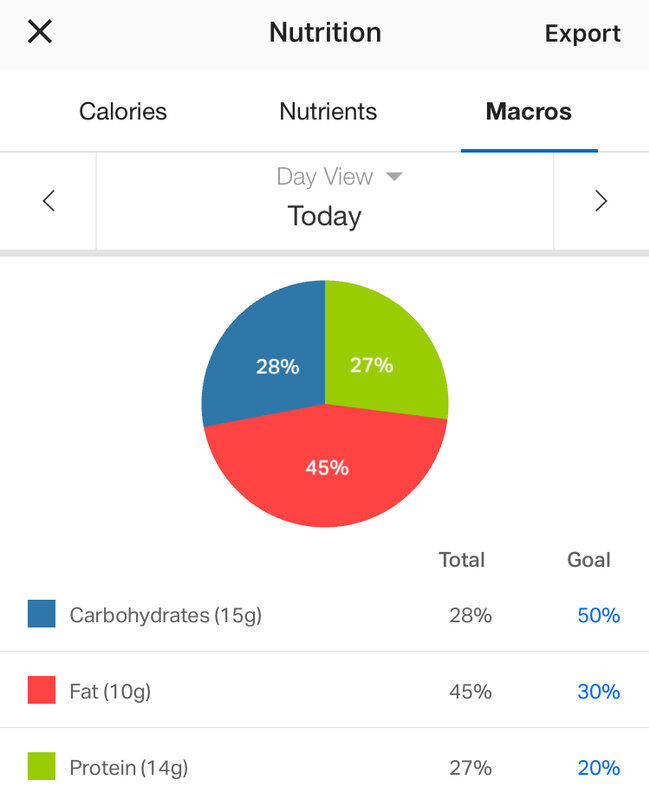
125 grams of protein will seem high at first, but I promise, it will make a difference in how you feel. 2000 calories with high protein will satisfy much more than 2500 with a low amount. Plus if you’re trying to lose weight, eating high protein will help you shred body fat instead of precious muscle.
Now to actually hit such a high protein number, you can eat the conventional chicken breast, turkey, and other lean meats, but it also helps to have other options. So here are a few of my faves:
#1 Sardines
Yes, they stink, but they are delicious.
Sardines are a great snack and I love tacking them on to meals when I’m not quite full.
I usually buy skinless and boneless sardines in water with no added salt. Then I throw hot sauce on ‘em later to heat things up.
The brand I buy has about four fish per can. And these give me 22 grams of protein on only 170 calories.

If you do eat these though, please be respectful of people around you. Wash the can out with soap and keep some mints handy too. Otherwise, you’ll clear out rooms fast.
#2 Beef Jerky
I love jerky, man.
I’m a carnivore at heart, so any way I can add more meat to my diet is a plus.
Jerky is great because it’s a low calorie snack that’s very protein dense. A small bag of Jack Link’s beef jerky for example gives you 11 grams of protein with only 70 calories.
You do need to watch the sodium and sugar content of some brands though, and a few of them use preservatives that I avoid. But once you find a brand that keeps that stuff in check, you’ll have a great side you can add to any meal.
(Also see The Best and Worst Beef Jerky—Ranked at Eat This, Not That)
#3 Greek Yogurt
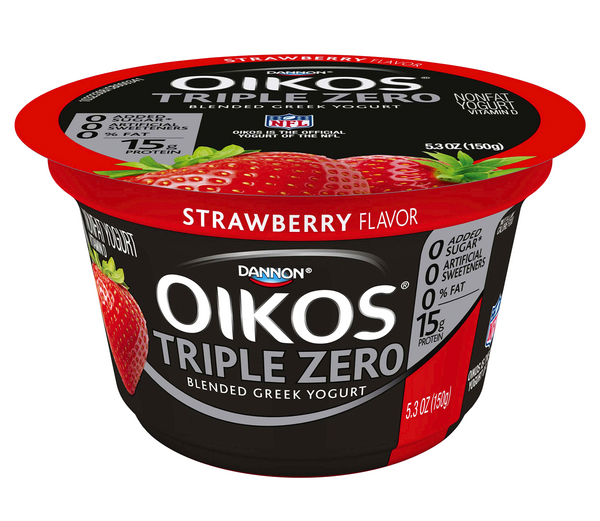 This stuff is great if you buy the right kind.
This stuff is great if you buy the right kind.
Dannon’s Oikos Triple Zero Blended Greek Yogurt is my personal favorite. Each serving is packed with 15 grams of protein at only 100 calories each. It’s also low on sugar at about 5 grams.
The taste is similar to normal yogurt but the texture is slightly thicker. Once you eat a serving or two you’ll be used to that though.
The Oikos brand has a variety of good flavors to choose from, but I recommend vanilla and strawberry to start out.
#4 Protein Bars
Yes, many protein bars taste like cardboard, but if you pick the right ones, they’ll be a filling supplement to a high protein diet.
Now granted, you may want to avoid them if you’re real picky about ingredients. I’m more concerned about hitting protein and calorie goals though, so I don’t care.
Grenade’s Carb Killa protein bars are some of the best tasting ones I’ve had. They’ll give you 20 grams of protein on about 200 calories, and they really do taste like candy bars.
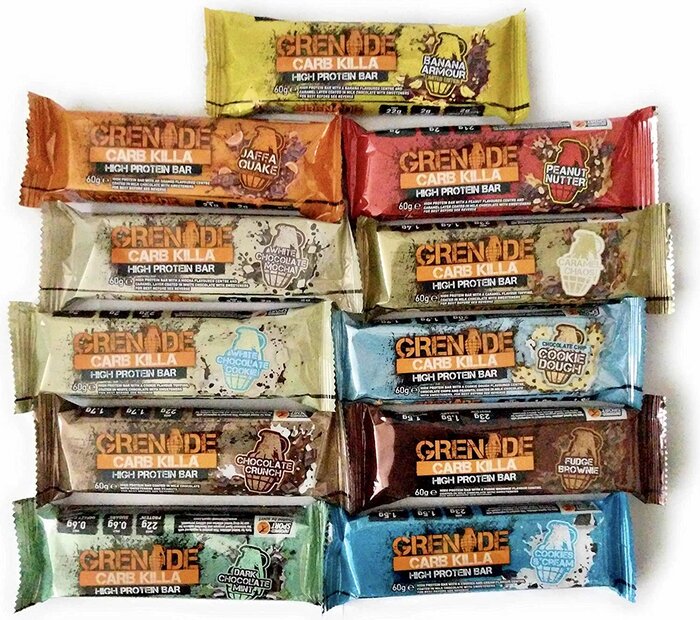
These things can be a little pricey though, so I usually buy them on Amazon when they go on sale (affiliate link). You can get a pack of 12 for about 20 bucks during that time.
Every flavor I’ve tried has been good so far, but you can’t go wrong with the Peanut Nutter, Caramel Chaos, or White Chocolate Salted Peanut.
Tip #3: Try Intermittent Fasting
I will preach the benefits of IF till I’m six feet under.
I first tried this style of eating in 2014 and haven’t looked back since.
Most days I stick to the 16:8 eating schedule, which means I go 16 hours without food and then eat within an 8 hour window. This means all my daily calories are crammed into those eight hours.
Eating an early breakfast or fetching a midnight snack is out of the question, and this discipline IF requires keeps me in check. I’m not tempted to eat at night because I never eat at night. It would just feel wrong to do so.
But besides shrinking my eating times, intermittent fasting has also trained me to survive longer without food.
I rarely feel like I’m starving even if I wait till noon to eat my first meal. Most times I only feel a light hunger, and even that goes away when I commit to long fasts.
Tip #4: Drink Water with Everything
 Save your calories for solid food. That is one of the easiest ways to make a calorie deficit. Most people can easily cut 300 calories a day just by swapping their drinks with water.
Save your calories for solid food. That is one of the easiest ways to make a calorie deficit. Most people can easily cut 300 calories a day just by swapping their drinks with water.
Again, this goes back to being calorie conscious. All the sodas, alcohol, sugary teas and coffees are not freebies. Just because they don’t make you full it doesn’t mean they don’t have calories.
If you’re going to add to your calorie total, make sure it’s something with substance, not a drink.
The great thing about water is that it’s calorie-free. You can drink as much as you want without hurting your diet.
I personally shoot for 3 liters a day (which is a little less than a gallon). Drinking this much water keeps me hydrated, it cleans my system, and it helps me feel full.
If portion control is an issue for you, drink a glass of water before and after your meal. Doing that will fill your stomach without adding additional calories.
Also, if you get hungry throughout the day, keep some water on hand and gulp it down when the cravings come. You’ll probably notice later that you were just thirsty the whole time.
Tip #5: Plan and Prep Your Meals
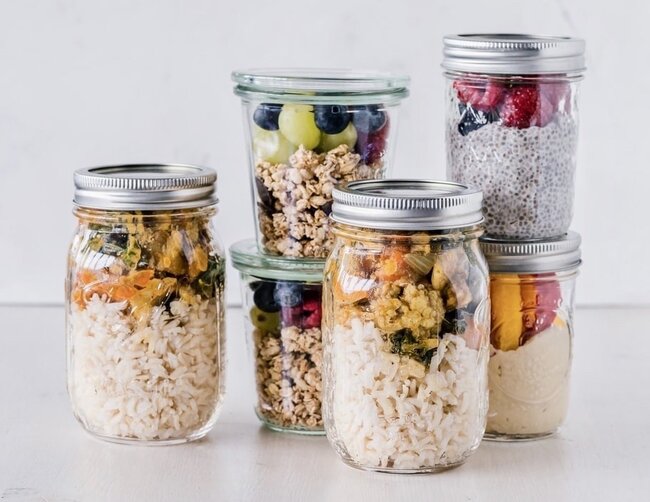 A great way to control your calorie intake is to plan and prep meals beforehand.
A great way to control your calorie intake is to plan and prep meals beforehand.
You don’t want to wait till you’re hungry to start looking for food. That’s like going to the grocery store when you’re starving—you’ll walk out with a bunch of garbage you don’t need.
I almost always prep my lunch the night before work. I get a rough estimate of how many calories I want to consume and then adjust my choices and portions to match. Doing this removes the guesswork at lunch time and it allows me to eat guilt free.
To me, it’s like budgeting before you go shopping. People who buy stuff on a whim make emotional choices and they’re often surprised by how much they spend. But if you make a budget before you start spending, you’ll have boundaries that keep you in check, and bills won’t scare you later because that was money you planned to use.
If you do a lot of cooking, you can also prep your meals for the week during the weekend. That will give you more time to prep everything and remove the stress of having to rush home and cook later.
Planning your meals early like this also gives you something to look forward to. You know you’re going to enjoy a guilt-free meal at a certain time, so you can chow down later without a care.
Just make sure you stick to your plan though. Once you’ve finished eating, drink a glass of water and walk away. If you want a “harmless” dessert next time, plan for it.
Tip #6: Choose Smart Substitutes
 My fellow Americans are well aware our country’s gluttonous ways.
My fellow Americans are well aware our country’s gluttonous ways.
Portion sizes here are huge, calorie dense foods are common, and basic nutrition is ignored. The system’s designed to make us obese, and we’re trained to accept growing waistlines as normal.
But while I admit that cultures like this aren’t helpful, there are still choices you can make to fight back. And one of these choices is the decision to make smart substitutes.
Choosing grilled foods instead of fried is a great way to cut calories for example. It’s also wise to look for low calorie versions of your favorite condiments too.
If you routinely eat stuff like mayo and ranch, get the reduced fat versions. Fat is the most calorie dense macronutrient, so buying anything that slashes it will lower the calories. Many low fat substitutes have half the calories and taste very similar to the original.
Also, if you’re someone who can’t go without your caffeine fix, try green tea instead of loaded up coffee. Green tea has zero calories, it still provides a nice buzz, and it won’t give you the dreaded coffee breath either.
Sugar free gum is another substitute for chain chewers like myself. If I’m not careful, I can easily chew a pack a day, but my sugar-free sticks only have 5 calories and none of the extra sweetness.
All of these are small changes that really do add up. So please don’t blindly grab stuff the next time you shop. Scan nutrition labels and compare your favorite items to substitutes. Then make the smartest choice you can.
Tip #7: Don’t Fear Frozen
 I’ll be honest here: I don’t like cooking.
I’ll be honest here: I don’t like cooking.
No, I’m not the worst at it. It’s just inefficient.
Why would I spend an hour or longer making food that’ll be gone in ten minutes?
It doesn’t make sense to me. And that’s one reason why I’m a fan of frozen meals. They’re convenient, they’re portion controlled, and most are fairly cheap too.
Yes, frozen meals are notorious for having high sodium, tons of fat, and meat that tastes like rubber, but the frozen market has evolved a lot in recent years. Brands like Lean Cuisine, Healthy Choice, and Evol have delicious, portion-controlled options you can eat in minutes. You just need to know what to look for.
I’m partial to the frozen bowls many brands have, but no matter which meal I buy, I look for 3 things on the label:
- Less than 400 calories
- Less than 800mg of sodium
- At least 20g of protein
These are loose limits by the way—I won’t reject a meal because it only has 19 grams of protein—but for the most part, I stay true to this list.
Most frozen meals I buy cost about $2.50 each. The more expensive ones cost about a dollar more. So overall, the prices aren’t bad.
We talked about substitutes earlier too, and I think (the right) frozen meals are a great substitute for fast food. The calorie and sodium counts will be much lower if you use my criteria. Plus you’ll get all the protein you need to stay full.
Good frozen meals also use natural ingredients, they include plenty of vegetables, and they avoid weird preservatives—which is a rarity with fast food. That’s why I stock up every few weeks so I have meals ready when I want something fast.
But with all that said, I highly recommend frozen meals. They’re a great addition to any low calorie diet. And to give you some ideas if you’re interested, here are a few of my favorites:
Lean Cuisine Shrimp Alfredo Bowl
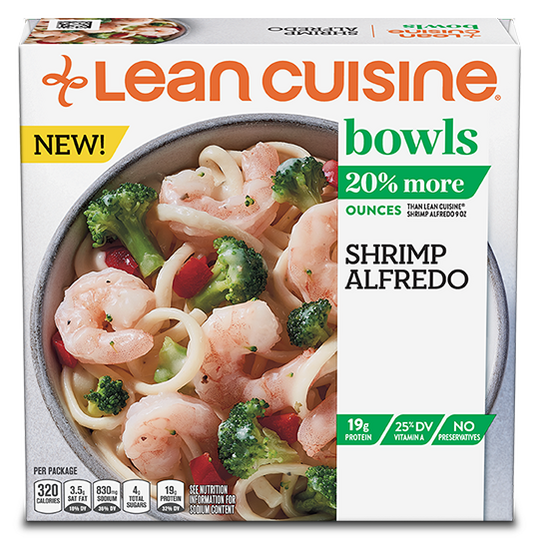 Lean Cuisine’s Shrimp Alfredo Bowl is a testament to how far frozen meals have come.
Lean Cuisine’s Shrimp Alfredo Bowl is a testament to how far frozen meals have come.
A generous portion of well-cooked shrimp, fresh-tasting broccoli, red peppers, garlic Alfredo sauce, and linguine in a $2.50 package would be unheard of before. And that’s without mentioning that it has 19 grams of protein and only 320 calories.
Now this meal does slightly eclipse my sodium cutoff, but it’s unique flavor and solid nutrition values keep it in my rotation. Pre-cooked seafood is always hit or miss, but the shrimp in this meal is excellent—especially when you consider the price.
My only drawback with this meal is that the sauce isn’t consistent. Sometimes it’s creamier, which I like, but other times it’s a little watery.
Overall, it’s a fine meal though. It adds much needed variety to your standard low-calorie diet.
Evol Chicken Enchilada Bake
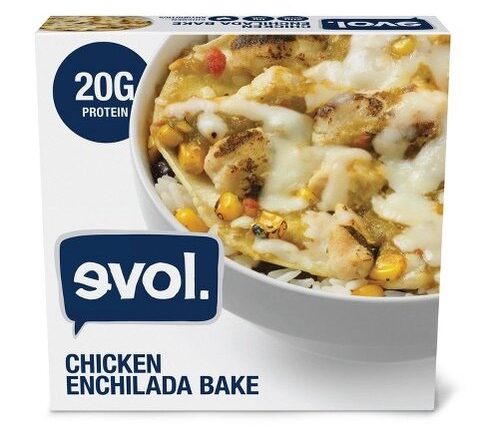 Evol’s Chicken Enchilada Bake is my go-to for a southwestern frozen meal. It has tender white meat chicken, black beans, corn, cheddar cheese, white rice, and even a corn tortilla. That’s all topped with a green enchilada sauce that brings this amazing meal together.
Evol’s Chicken Enchilada Bake is my go-to for a southwestern frozen meal. It has tender white meat chicken, black beans, corn, cheddar cheese, white rice, and even a corn tortilla. That’s all topped with a green enchilada sauce that brings this amazing meal together.
I honestly get excited when I pack one of these for lunch. It tastes great and people always comment on how good it smells.
This thing has 20 grams of protein, less than 400 calories, and a relatively small amount of sodium (500 mg).
I like it a lot and it’s one of the best frozen meals in my rotation. Other people must think so too since they sell out so fast at local stores.
I will note that Evol products are somewhat pricey compared to similar meals, but this one isn’t too bad at around $3.50.
Healthy Choice Chicken Marinara Power Bowl
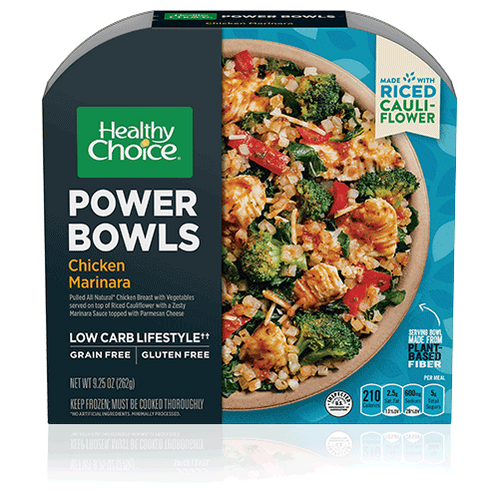 Healthy Choice is a great brand for calorie conscious folk like myself. Their meals are pretty cheap and most have good portion sizes with less than 300 calories.
Healthy Choice is a great brand for calorie conscious folk like myself. Their meals are pretty cheap and most have good portion sizes with less than 300 calories.
One of their more interesting meals is the Chicken Marinara Power Bowl with riced cauliflower. It’s filled with chicken, riced cauliflower, kale, spinach, broccoli, parmesan cheese, red bell pepper strips, and marinara sauce.
I was hesitant about the riced cauliflower at first, but it really doesn’t taste much different than rice. This substitution also keep carbs low compared to the other meals I mentioned, so if that’s a concern for you, give it a try.
This thing has 19 grams of protein, plenty of vegetables, and fewer calories than a bag of Doritos. So why not pick it up?
Don’t Worry, You Can Do This
- Become calorie conscious
- Eat more protein
- Try intermittent fasting
- Drink water with everything
- Plan and prep your meals
- Make smart substitutes
- Don’t fear frozen
Those are my 7 tips to eat less without feeling hungry.
A lot of people make nutrition harder than it needs to be, but hopefully you see how simple these actions are.
Let me know which tips here stood out to you. And if you have any of your own to share, I’ll be glad to read ‘em below.
-Drew
Stock Photo Credits (in order of appearance): Anfisa Eremina on Pexels, KOBU Agency on Unsplash, Ella Olsson on Unsplash, Buenosia Carol on Pexels, cottonbro on Pexels
IF is awesome.
Great tips here.
I personally don’t do #7 but that is OK!
Yeah, I’m a big fan of IF. Easily the best thing I ever did to change my eating habits.
I’m glad you found the rest of the post helpful too!